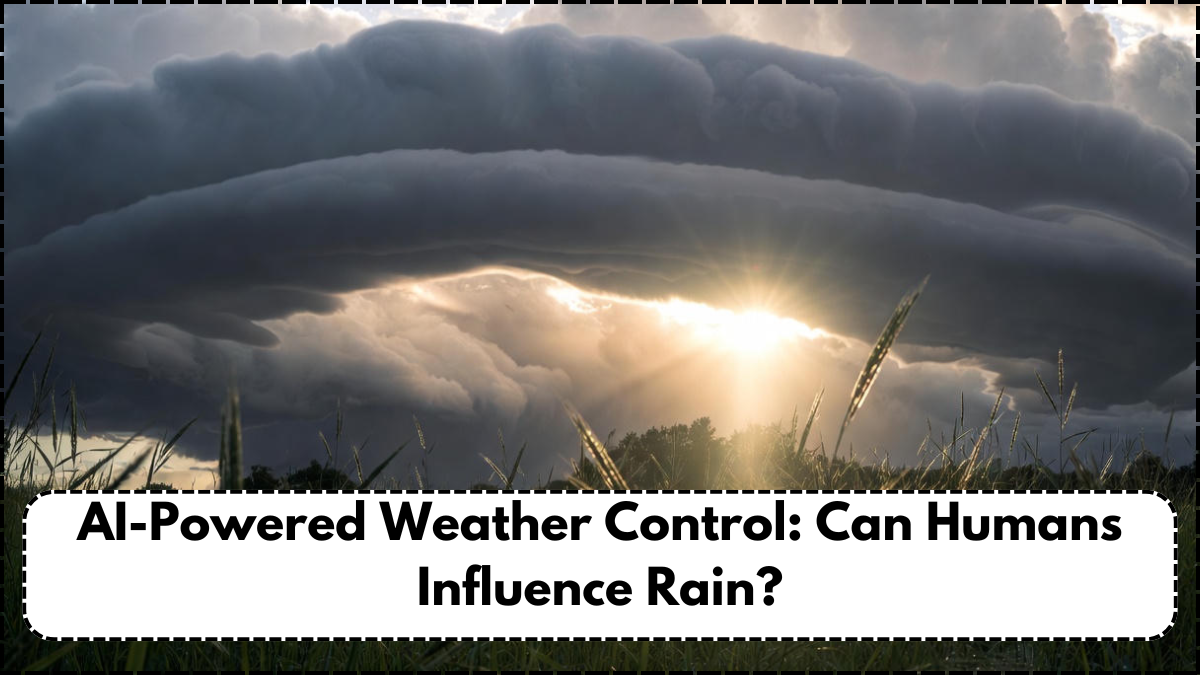The concept of AI weather control has moved from science fiction to scientific exploration as researchers develop new ways to influence rainfall, storms, and atmospheric patterns. With climate change causing extreme weather and unpredictable seasons, the demand for advanced climate tech has increased dramatically. Today’s innovations aim not just to forecast weather, but to modify it with precision. Through cloud seeding, atmospheric monitoring, and AI-driven simulations, AI weather control is emerging as a potential tool for drought prevention, disaster management, and sustainable agriculture.

How AI Weather Control Works
The foundation of AI weather control lies in collecting massive amounts of atmospheric data and analyzing it using machine learning models. These models evaluate humidity, wind movement, air pressure, temperature variation, and cloud density. Combined with climate tech, this data enables researchers to determine the most effective strategies for influencing rainfall and stabilizing weather patterns.
Cloud seeding, one of the most widely used techniques, involves dispersing particles into clouds to encourage precipitation. When guided by AI weather control models, the accuracy and timing of cloud seeding significantly improve. With AI detecting the optimal cloud type, wind direction, and atmospheric chemistry, rainfall can be induced more efficiently, with fewer resources and better environmental impact.
Technology Behind AI Weather Modification
Modern AI weather control systems rely on sensors, satellites, and powerful computing platforms. These technologies gather real-time data, simulate thousands of climate scenarios, and calculate the best intervention methods. The addition of advanced climate tech allows experts to alter microclimates in specific regions.
Below is a table highlighting the main technologies that support AI weather control:
| Technology | Function | Impact |
|---|---|---|
| Satellite Monitoring | Tracks atmospheric patterns | Provides accurate real-time climate data |
| AI Climate Models | Simulate weather behavior | Enhances prediction and modification accuracy |
| Cloud Seeding Drones | Disperse cloud-forming particles | Increases chances of controlled rainfall |
| Atmospheric Sensors | Collect humidity and pressure data | Helps optimize intervention timing |
| Climate Tech Systems | Tools to regulate microclimates | Supports sustainable weather management |
Together, these tools allow governments and researchers to make informed decisions. AI weather control becomes more reliable when supported by modern climate tech, helping nations prepare for extreme climate conditions more effectively.
Global Benefits and Ethical Concerns
The potential benefits of AI weather control are enormous. Regions suffering from prolonged droughts could receive targeted rainfall, improving agricultural output and water supply. Climate tech innovations could help reduce the impact of hurricanes by weakening storm formations before they reach populated areas. Flood-prone zones may also benefit from early rainfall diversion strategies.
Some major benefits include:
- Controlled rainfall during droughts
- Better agricultural productivity
- Reduced risk of natural disasters
- Enhanced water management systems
- Improved climate forecasting with AI
- Optimized use of resources for weather modification
However, these benefits come with ethical questions. Who gets to control the weather? Could AI weather control unintentionally disrupt natural ecosystems? Misuse of such powerful climate tech might cause political tension, especially if weather modifications affect neighboring regions. Therefore, strict global regulations and transparency are essential to ensure safe and fair usage.
Future Scope of AI Weather Control
The future of AI weather control is filled with exciting possibilities. As machine learning models become more advanced, they will predict weather patterns with near-perfect precision. This will allow climate tech systems to perform real-time interventions, potentially preventing severe disasters before they occur.
Researchers are developing AI that can control cloud formation, atmospheric pressure, and even temperature at localized levels. In the coming years, cities may be able to create artificial rainfall, regulate heat waves, or disperse smog using intelligent weather management systems. With stronger governance and global cooperation, AI weather control may become one of the most valuable tools for combating climate change.
Conclusion
The rise of AI weather control represents a major leap forward in climate innovation. When combined with advanced climate tech, these systems offer the potential to reduce droughts, protect agriculture, and minimize damage from natural disasters. As the technology continues to evolve, it must be used responsibly, ensuring ethical standards and environmental safety. The future promises a world where humans can influence weather with precision, creating a safer and more stable climate for future generations.
FAQs
What is AI weather control?
AI weather control is the use of artificial intelligence to analyze, predict, and influence weather patterns using advanced climate tech tools.
Can AI really make it rain?
Yes, AI models can guide cloud seeding and optimize conditions for rainfall, making controlled rain more effective through climate tech systems.
Is AI weather control safe for the environment?
When regulated properly, AI weather control can be environmentally safe, though long-term studies are still ongoing.
How does climate tech support weather modification?
Climate tech provides sensors, drones, and atmospheric tools that help implement AI-driven weather modification techniques.
Will AI weather control become common in the future?
Experts predict that AI weather control will become more widespread as technology advances and global climate challenges intensify.
Click here to learn more